GEOG1104: Investigating Ozone Depletion with PSR Model Application
VerifiedAdded on 2023/03/31
|15
|2831
|227
Report
AI Summary
This report provides an analysis of ozone layer depletion, its causes, and possible impacts, using the Pressure-State-Response (PSR) framework, focusing on the Brigalow Belt region of New South Wales. It discusses the nature of stratospheric ozone depletion, highlighting the role of CFCs and other substances, and references the Montreal Protocol as a global response. The report identifies key pressure indicators like the production of ozone-depleting substances, state indicators such as atmospheric ozone levels and chlorine concentrations, and response indicators including international agreements and national policies. It further details the reduction in ozone-depleting substance production due to the Montreal Protocol and national efforts to phase out methyl bromide, offering data sources and treaty relevance. The analysis concludes by emphasizing the importance of monitoring atmospheric levels of ozone-depleting substances to ensure compliance with international laws and the effectiveness of phase-out limits.
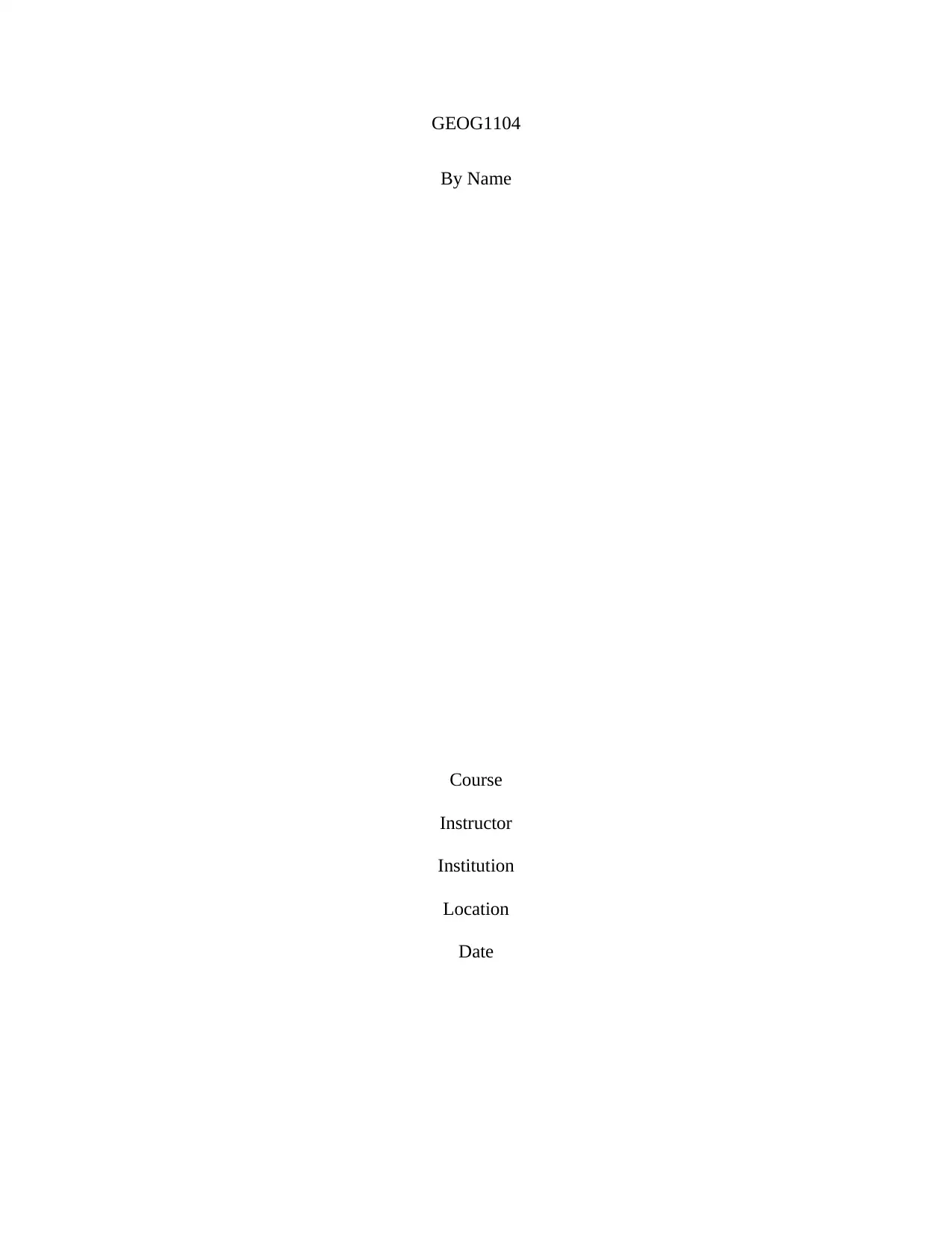
GEOG1104
By Name
Course
Instructor
Institution
Location
Date
By Name
Course
Instructor
Institution
Location
Date
Paraphrase This Document
Need a fresh take? Get an instant paraphrase of this document with our AI Paraphraser
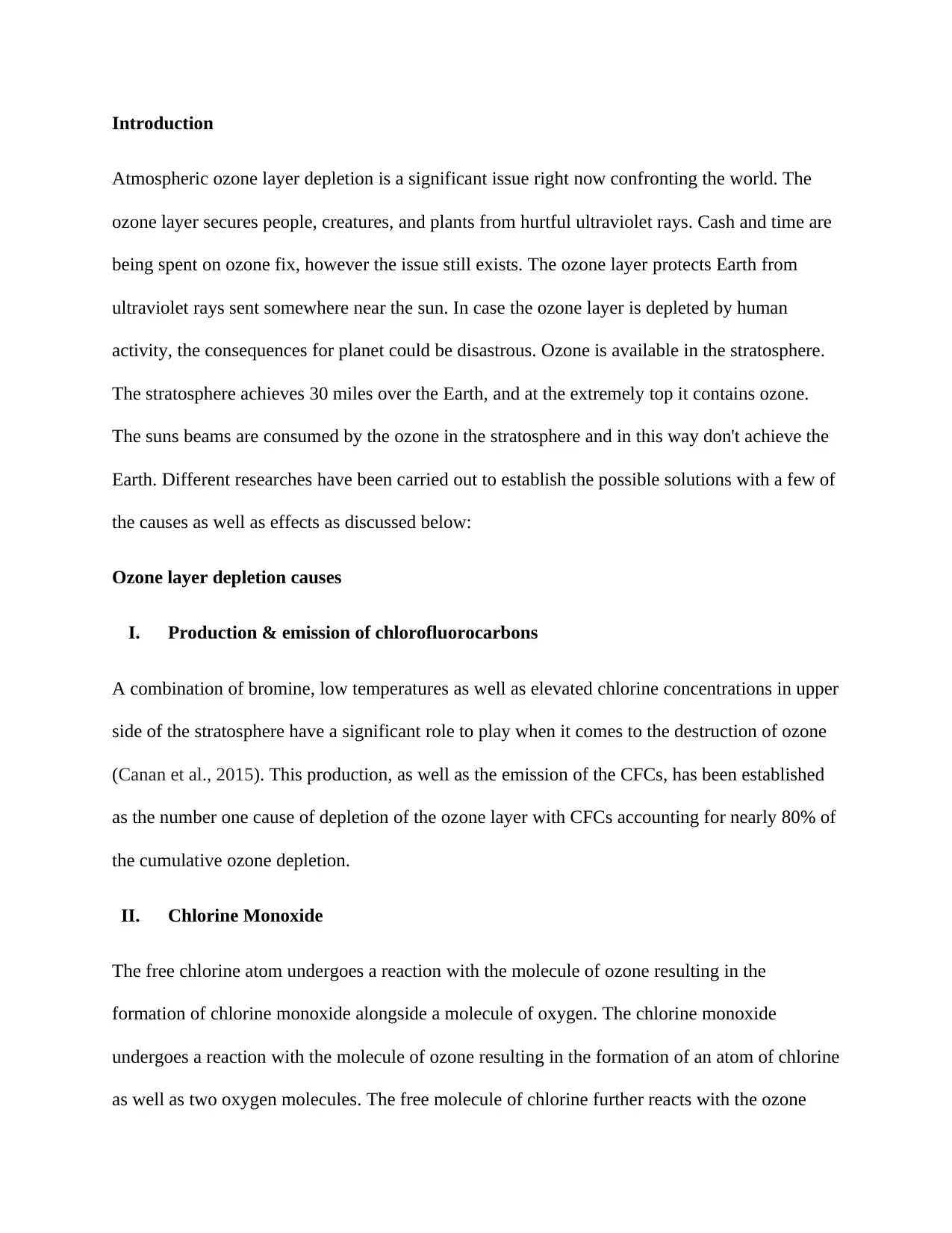
Introduction
Atmospheric ozone layer depletion is a significant issue right now confronting the world. The
ozone layer secures people, creatures, and plants from hurtful ultraviolet rays. Cash and time are
being spent on ozone fix, however the issue still exists. The ozone layer protects Earth from
ultraviolet rays sent somewhere near the sun. In case the ozone layer is depleted by human
activity, the consequences for planet could be disastrous. Ozone is available in the stratosphere.
The stratosphere achieves 30 miles over the Earth, and at the extremely top it contains ozone.
The suns beams are consumed by the ozone in the stratosphere and in this way don't achieve the
Earth. Different researches have been carried out to establish the possible solutions with a few of
the causes as well as effects as discussed below:
Ozone layer depletion causes
I. Production & emission of chlorofluorocarbons
A combination of bromine, low temperatures as well as elevated chlorine concentrations in upper
side of the stratosphere have a significant role to play when it comes to the destruction of ozone
(Canan et al., 2015). This production, as well as the emission of the CFCs, has been established
as the number one cause of depletion of the ozone layer with CFCs accounting for nearly 80% of
the cumulative ozone depletion.
II. Chlorine Monoxide
The free chlorine atom undergoes a reaction with the molecule of ozone resulting in the
formation of chlorine monoxide alongside a molecule of oxygen. The chlorine monoxide
undergoes a reaction with the molecule of ozone resulting in the formation of an atom of chlorine
as well as two oxygen molecules. The free molecule of chlorine further reacts with the ozone
Atmospheric ozone layer depletion is a significant issue right now confronting the world. The
ozone layer secures people, creatures, and plants from hurtful ultraviolet rays. Cash and time are
being spent on ozone fix, however the issue still exists. The ozone layer protects Earth from
ultraviolet rays sent somewhere near the sun. In case the ozone layer is depleted by human
activity, the consequences for planet could be disastrous. Ozone is available in the stratosphere.
The stratosphere achieves 30 miles over the Earth, and at the extremely top it contains ozone.
The suns beams are consumed by the ozone in the stratosphere and in this way don't achieve the
Earth. Different researches have been carried out to establish the possible solutions with a few of
the causes as well as effects as discussed below:
Ozone layer depletion causes
I. Production & emission of chlorofluorocarbons
A combination of bromine, low temperatures as well as elevated chlorine concentrations in upper
side of the stratosphere have a significant role to play when it comes to the destruction of ozone
(Canan et al., 2015). This production, as well as the emission of the CFCs, has been established
as the number one cause of depletion of the ozone layer with CFCs accounting for nearly 80% of
the cumulative ozone depletion.
II. Chlorine Monoxide
The free chlorine atom undergoes a reaction with the molecule of ozone resulting in the
formation of chlorine monoxide alongside a molecule of oxygen. The chlorine monoxide
undergoes a reaction with the molecule of ozone resulting in the formation of an atom of chlorine
as well as two oxygen molecules. The free molecule of chlorine further reacts with the ozone
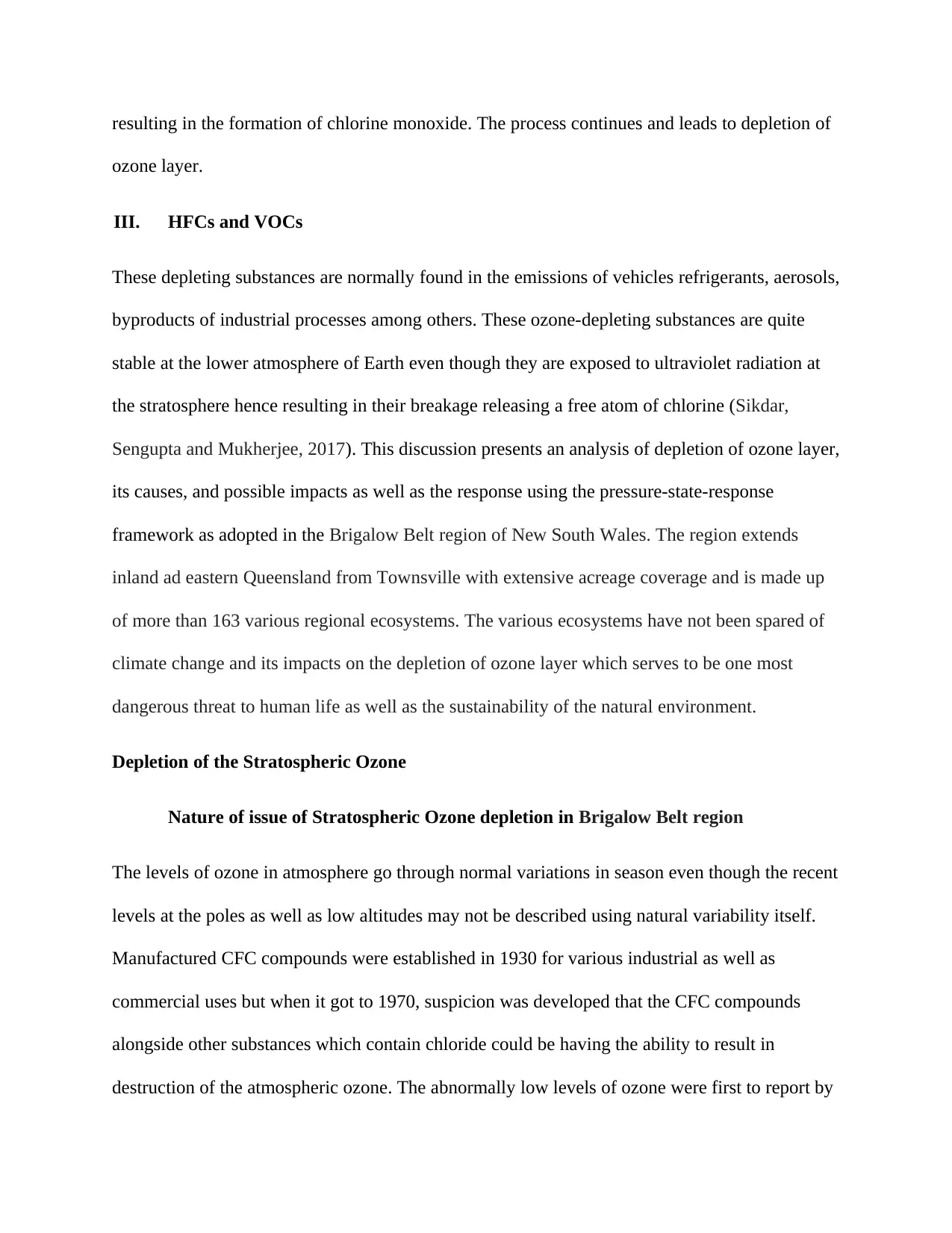
resulting in the formation of chlorine monoxide. The process continues and leads to depletion of
ozone layer.
III. HFCs and VOCs
These depleting substances are normally found in the emissions of vehicles refrigerants, aerosols,
byproducts of industrial processes among others. These ozone-depleting substances are quite
stable at the lower atmosphere of Earth even though they are exposed to ultraviolet radiation at
the stratosphere hence resulting in their breakage releasing a free atom of chlorine (Sikdar,
Sengupta and Mukherjee, 2017). This discussion presents an analysis of depletion of ozone layer,
its causes, and possible impacts as well as the response using the pressure-state-response
framework as adopted in the Brigalow Belt region of New South Wales. The region extends
inland ad eastern Queensland from Townsville with extensive acreage coverage and is made up
of more than 163 various regional ecosystems. The various ecosystems have not been spared of
climate change and its impacts on the depletion of ozone layer which serves to be one most
dangerous threat to human life as well as the sustainability of the natural environment.
Depletion of the Stratospheric Ozone
Nature of issue of Stratospheric Ozone depletion in Brigalow Belt region
The levels of ozone in atmosphere go through normal variations in season even though the recent
levels at the poles as well as low altitudes may not be described using natural variability itself.
Manufactured CFC compounds were established in 1930 for various industrial as well as
commercial uses but when it got to 1970, suspicion was developed that the CFC compounds
alongside other substances which contain chloride could be having the ability to result in
destruction of the atmospheric ozone. The abnormally low levels of ozone were first to report by
ozone layer.
III. HFCs and VOCs
These depleting substances are normally found in the emissions of vehicles refrigerants, aerosols,
byproducts of industrial processes among others. These ozone-depleting substances are quite
stable at the lower atmosphere of Earth even though they are exposed to ultraviolet radiation at
the stratosphere hence resulting in their breakage releasing a free atom of chlorine (Sikdar,
Sengupta and Mukherjee, 2017). This discussion presents an analysis of depletion of ozone layer,
its causes, and possible impacts as well as the response using the pressure-state-response
framework as adopted in the Brigalow Belt region of New South Wales. The region extends
inland ad eastern Queensland from Townsville with extensive acreage coverage and is made up
of more than 163 various regional ecosystems. The various ecosystems have not been spared of
climate change and its impacts on the depletion of ozone layer which serves to be one most
dangerous threat to human life as well as the sustainability of the natural environment.
Depletion of the Stratospheric Ozone
Nature of issue of Stratospheric Ozone depletion in Brigalow Belt region
The levels of ozone in atmosphere go through normal variations in season even though the recent
levels at the poles as well as low altitudes may not be described using natural variability itself.
Manufactured CFC compounds were established in 1930 for various industrial as well as
commercial uses but when it got to 1970, suspicion was developed that the CFC compounds
alongside other substances which contain chloride could be having the ability to result in
destruction of the atmospheric ozone. The abnormally low levels of ozone were first to report by
⊘ This is a preview!⊘
Do you want full access?
Subscribe today to unlock all pages.

Trusted by 1+ million students worldwide
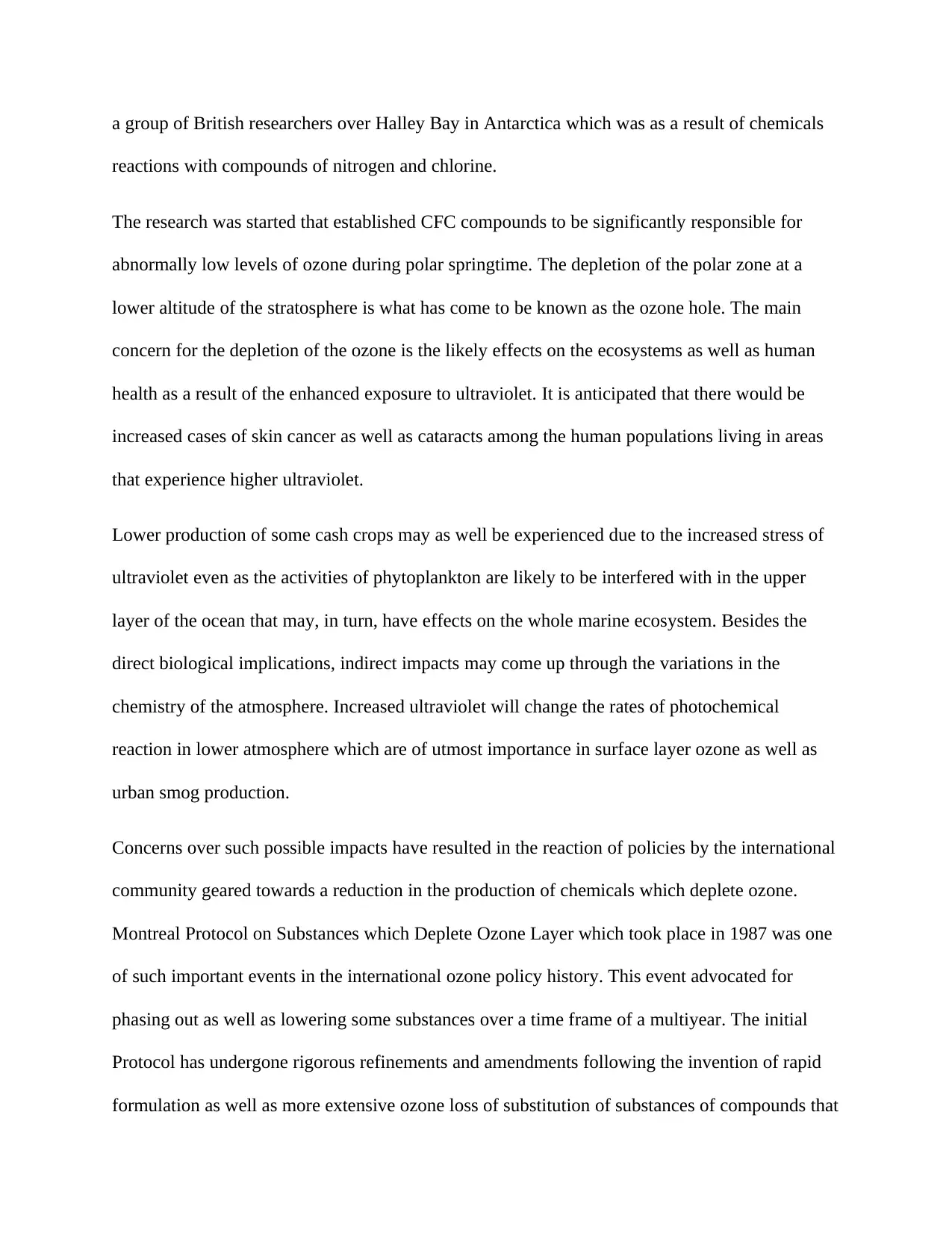
a group of British researchers over Halley Bay in Antarctica which was as a result of chemicals
reactions with compounds of nitrogen and chlorine.
The research was started that established CFC compounds to be significantly responsible for
abnormally low levels of ozone during polar springtime. The depletion of the polar zone at a
lower altitude of the stratosphere is what has come to be known as the ozone hole. The main
concern for the depletion of the ozone is the likely effects on the ecosystems as well as human
health as a result of the enhanced exposure to ultraviolet. It is anticipated that there would be
increased cases of skin cancer as well as cataracts among the human populations living in areas
that experience higher ultraviolet.
Lower production of some cash crops may as well be experienced due to the increased stress of
ultraviolet even as the activities of phytoplankton are likely to be interfered with in the upper
layer of the ocean that may, in turn, have effects on the whole marine ecosystem. Besides the
direct biological implications, indirect impacts may come up through the variations in the
chemistry of the atmosphere. Increased ultraviolet will change the rates of photochemical
reaction in lower atmosphere which are of utmost importance in surface layer ozone as well as
urban smog production.
Concerns over such possible impacts have resulted in the reaction of policies by the international
community geared towards a reduction in the production of chemicals which deplete ozone.
Montreal Protocol on Substances which Deplete Ozone Layer which took place in 1987 was one
of such important events in the international ozone policy history. This event advocated for
phasing out as well as lowering some substances over a time frame of a multiyear. The initial
Protocol has undergone rigorous refinements and amendments following the invention of rapid
formulation as well as more extensive ozone loss of substitution of substances of compounds that
reactions with compounds of nitrogen and chlorine.
The research was started that established CFC compounds to be significantly responsible for
abnormally low levels of ozone during polar springtime. The depletion of the polar zone at a
lower altitude of the stratosphere is what has come to be known as the ozone hole. The main
concern for the depletion of the ozone is the likely effects on the ecosystems as well as human
health as a result of the enhanced exposure to ultraviolet. It is anticipated that there would be
increased cases of skin cancer as well as cataracts among the human populations living in areas
that experience higher ultraviolet.
Lower production of some cash crops may as well be experienced due to the increased stress of
ultraviolet even as the activities of phytoplankton are likely to be interfered with in the upper
layer of the ocean that may, in turn, have effects on the whole marine ecosystem. Besides the
direct biological implications, indirect impacts may come up through the variations in the
chemistry of the atmosphere. Increased ultraviolet will change the rates of photochemical
reaction in lower atmosphere which are of utmost importance in surface layer ozone as well as
urban smog production.
Concerns over such possible impacts have resulted in the reaction of policies by the international
community geared towards a reduction in the production of chemicals which deplete ozone.
Montreal Protocol on Substances which Deplete Ozone Layer which took place in 1987 was one
of such important events in the international ozone policy history. This event advocated for
phasing out as well as lowering some substances over a time frame of a multiyear. The initial
Protocol has undergone rigorous refinements and amendments following the invention of rapid
formulation as well as more extensive ozone loss of substitution of substances of compounds that
Paraphrase This Document
Need a fresh take? Get an instant paraphrase of this document with our AI Paraphraser
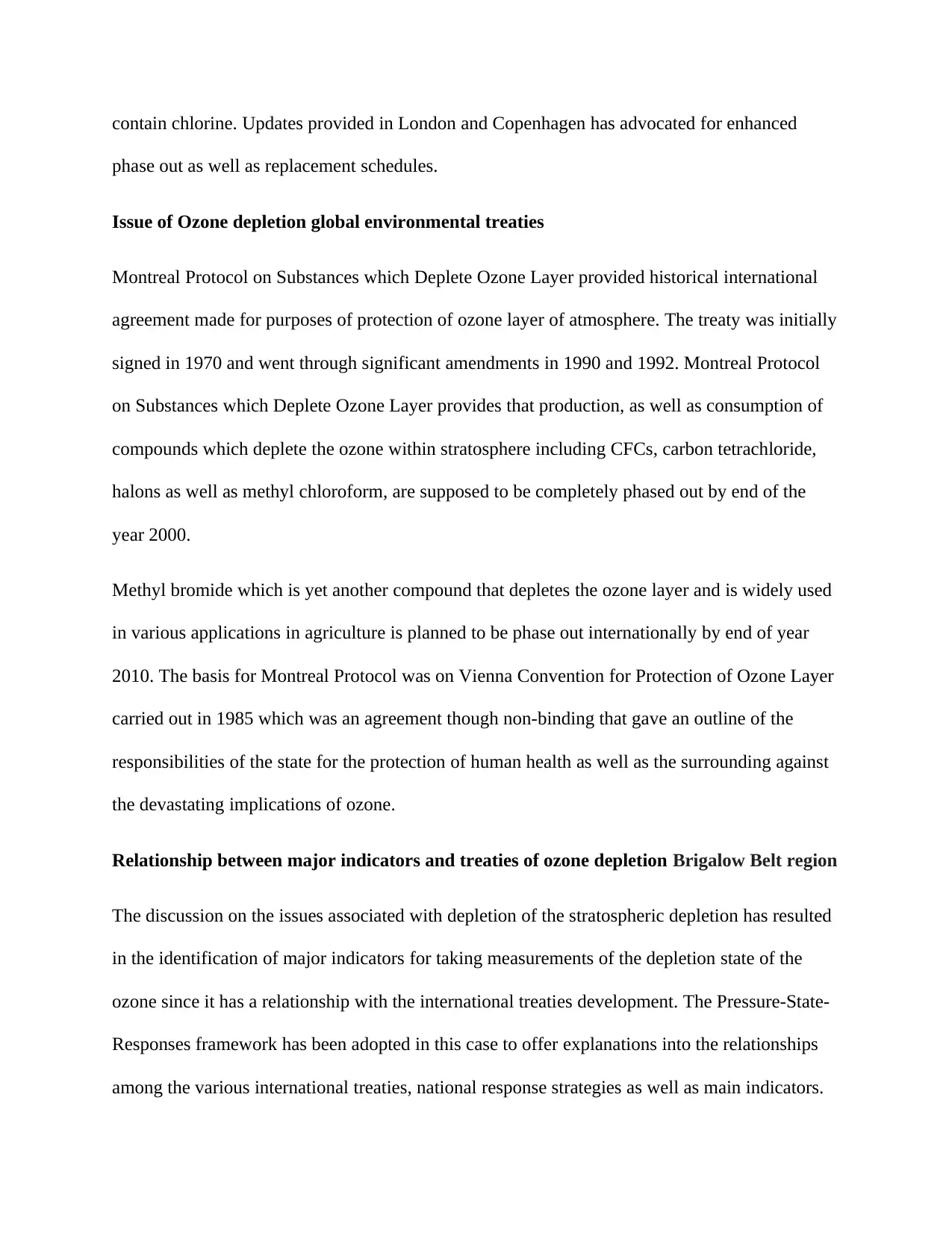
contain chlorine. Updates provided in London and Copenhagen has advocated for enhanced
phase out as well as replacement schedules.
Issue of Ozone depletion global environmental treaties
Montreal Protocol on Substances which Deplete Ozone Layer provided historical international
agreement made for purposes of protection of ozone layer of atmosphere. The treaty was initially
signed in 1970 and went through significant amendments in 1990 and 1992. Montreal Protocol
on Substances which Deplete Ozone Layer provides that production, as well as consumption of
compounds which deplete the ozone within stratosphere including CFCs, carbon tetrachloride,
halons as well as methyl chloroform, are supposed to be completely phased out by end of the
year 2000.
Methyl bromide which is yet another compound that depletes the ozone layer and is widely used
in various applications in agriculture is planned to be phase out internationally by end of year
2010. The basis for Montreal Protocol was on Vienna Convention for Protection of Ozone Layer
carried out in 1985 which was an agreement though non-binding that gave an outline of the
responsibilities of the state for the protection of human health as well as the surrounding against
the devastating implications of ozone.
Relationship between major indicators and treaties of ozone depletion Brigalow Belt region
The discussion on the issues associated with depletion of the stratospheric depletion has resulted
in the identification of major indicators for taking measurements of the depletion state of the
ozone since it has a relationship with the international treaties development. The Pressure-State-
Responses framework has been adopted in this case to offer explanations into the relationships
among the various international treaties, national response strategies as well as main indicators.
phase out as well as replacement schedules.
Issue of Ozone depletion global environmental treaties
Montreal Protocol on Substances which Deplete Ozone Layer provided historical international
agreement made for purposes of protection of ozone layer of atmosphere. The treaty was initially
signed in 1970 and went through significant amendments in 1990 and 1992. Montreal Protocol
on Substances which Deplete Ozone Layer provides that production, as well as consumption of
compounds which deplete the ozone within stratosphere including CFCs, carbon tetrachloride,
halons as well as methyl chloroform, are supposed to be completely phased out by end of the
year 2000.
Methyl bromide which is yet another compound that depletes the ozone layer and is widely used
in various applications in agriculture is planned to be phase out internationally by end of year
2010. The basis for Montreal Protocol was on Vienna Convention for Protection of Ozone Layer
carried out in 1985 which was an agreement though non-binding that gave an outline of the
responsibilities of the state for the protection of human health as well as the surrounding against
the devastating implications of ozone.
Relationship between major indicators and treaties of ozone depletion Brigalow Belt region
The discussion on the issues associated with depletion of the stratospheric depletion has resulted
in the identification of major indicators for taking measurements of the depletion state of the
ozone since it has a relationship with the international treaties development. The Pressure-State-
Responses framework has been adopted in this case to offer explanations into the relationships
among the various international treaties, national response strategies as well as main indicators.
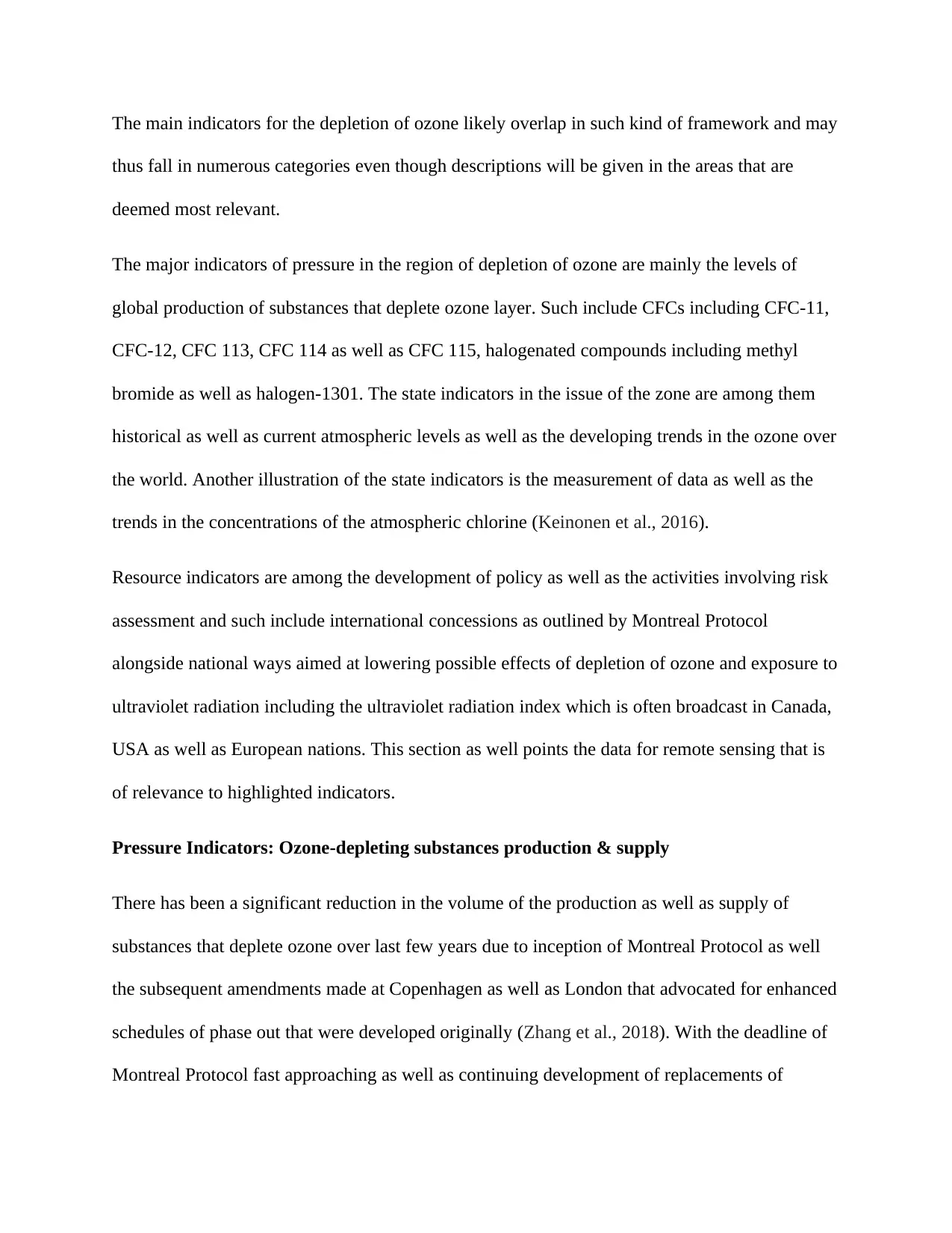
The main indicators for the depletion of ozone likely overlap in such kind of framework and may
thus fall in numerous categories even though descriptions will be given in the areas that are
deemed most relevant.
The major indicators of pressure in the region of depletion of ozone are mainly the levels of
global production of substances that deplete ozone layer. Such include CFCs including CFC-11,
CFC-12, CFC 113, CFC 114 as well as CFC 115, halogenated compounds including methyl
bromide as well as halogen-1301. The state indicators in the issue of the zone are among them
historical as well as current atmospheric levels as well as the developing trends in the ozone over
the world. Another illustration of the state indicators is the measurement of data as well as the
trends in the concentrations of the atmospheric chlorine (Keinonen et al., 2016).
Resource indicators are among the development of policy as well as the activities involving risk
assessment and such include international concessions as outlined by Montreal Protocol
alongside national ways aimed at lowering possible effects of depletion of ozone and exposure to
ultraviolet radiation including the ultraviolet radiation index which is often broadcast in Canada,
USA as well as European nations. This section as well points the data for remote sensing that is
of relevance to highlighted indicators.
Pressure Indicators: Ozone-depleting substances production & supply
There has been a significant reduction in the volume of the production as well as supply of
substances that deplete ozone over last few years due to inception of Montreal Protocol as well
the subsequent amendments made at Copenhagen as well as London that advocated for enhanced
schedules of phase out that were developed originally (Zhang et al., 2018). With the deadline of
Montreal Protocol fast approaching as well as continuing development of replacements of
thus fall in numerous categories even though descriptions will be given in the areas that are
deemed most relevant.
The major indicators of pressure in the region of depletion of ozone are mainly the levels of
global production of substances that deplete ozone layer. Such include CFCs including CFC-11,
CFC-12, CFC 113, CFC 114 as well as CFC 115, halogenated compounds including methyl
bromide as well as halogen-1301. The state indicators in the issue of the zone are among them
historical as well as current atmospheric levels as well as the developing trends in the ozone over
the world. Another illustration of the state indicators is the measurement of data as well as the
trends in the concentrations of the atmospheric chlorine (Keinonen et al., 2016).
Resource indicators are among the development of policy as well as the activities involving risk
assessment and such include international concessions as outlined by Montreal Protocol
alongside national ways aimed at lowering possible effects of depletion of ozone and exposure to
ultraviolet radiation including the ultraviolet radiation index which is often broadcast in Canada,
USA as well as European nations. This section as well points the data for remote sensing that is
of relevance to highlighted indicators.
Pressure Indicators: Ozone-depleting substances production & supply
There has been a significant reduction in the volume of the production as well as supply of
substances that deplete ozone over last few years due to inception of Montreal Protocol as well
the subsequent amendments made at Copenhagen as well as London that advocated for enhanced
schedules of phase out that were developed originally (Zhang et al., 2018). With the deadline of
Montreal Protocol fast approaching as well as continuing development of replacements of
⊘ This is a preview!⊘
Do you want full access?
Subscribe today to unlock all pages.

Trusted by 1+ million students worldwide
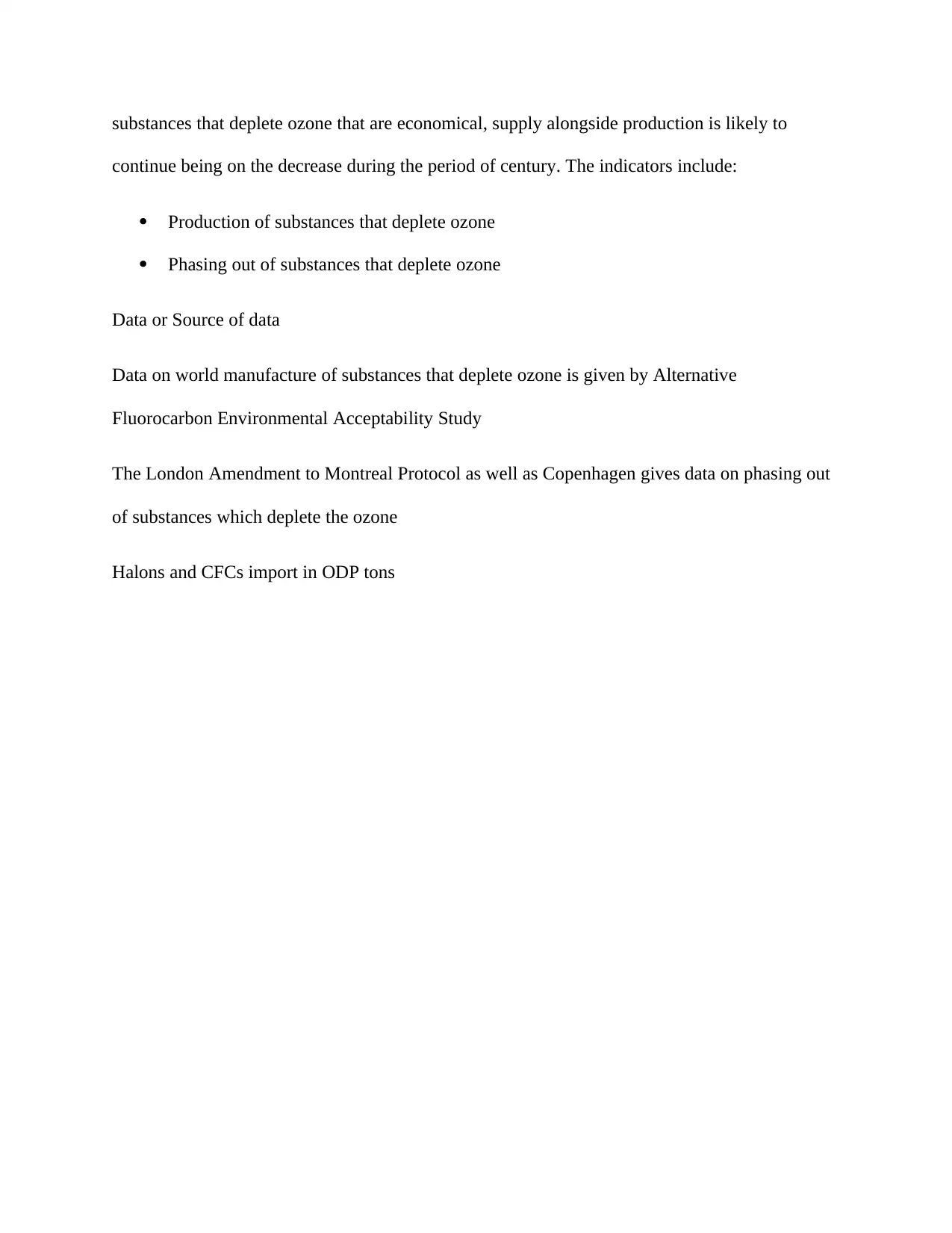
substances that deplete ozone that are economical, supply alongside production is likely to
continue being on the decrease during the period of century. The indicators include:
Production of substances that deplete ozone
Phasing out of substances that deplete ozone
Data or Source of data
Data on world manufacture of substances that deplete ozone is given by Alternative
Fluorocarbon Environmental Acceptability Study
The London Amendment to Montreal Protocol as well as Copenhagen gives data on phasing out
of substances which deplete the ozone
Halons and CFCs import in ODP tons
continue being on the decrease during the period of century. The indicators include:
Production of substances that deplete ozone
Phasing out of substances that deplete ozone
Data or Source of data
Data on world manufacture of substances that deplete ozone is given by Alternative
Fluorocarbon Environmental Acceptability Study
The London Amendment to Montreal Protocol as well as Copenhagen gives data on phasing out
of substances which deplete the ozone
Halons and CFCs import in ODP tons
Paraphrase This Document
Need a fresh take? Get an instant paraphrase of this document with our AI Paraphraser
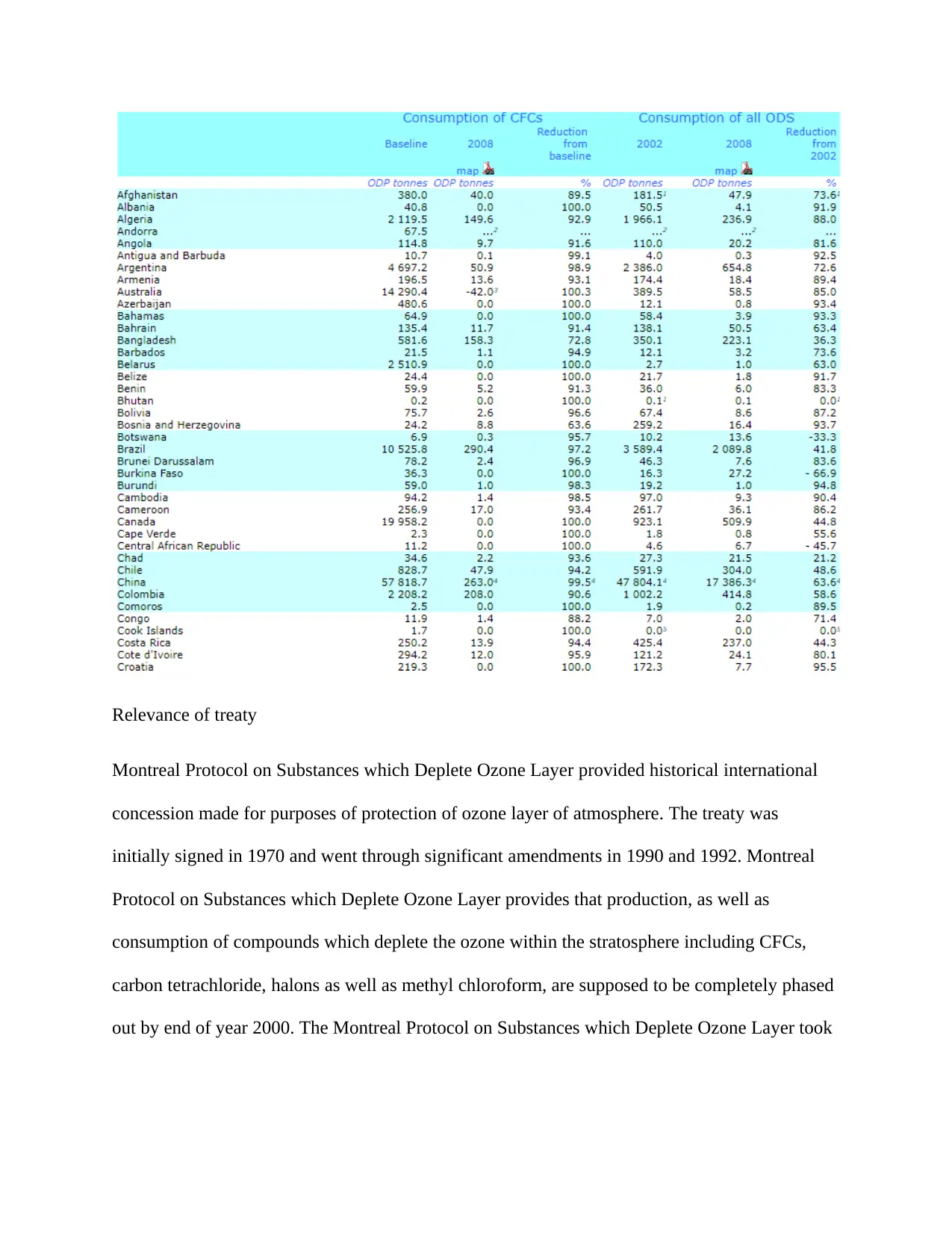
Relevance of treaty
Montreal Protocol on Substances which Deplete Ozone Layer provided historical international
concession made for purposes of protection of ozone layer of atmosphere. The treaty was
initially signed in 1970 and went through significant amendments in 1990 and 1992. Montreal
Protocol on Substances which Deplete Ozone Layer provides that production, as well as
consumption of compounds which deplete the ozone within the stratosphere including CFCs,
carbon tetrachloride, halons as well as methyl chloroform, are supposed to be completely phased
out by end of year 2000. The Montreal Protocol on Substances which Deplete Ozone Layer took
Montreal Protocol on Substances which Deplete Ozone Layer provided historical international
concession made for purposes of protection of ozone layer of atmosphere. The treaty was
initially signed in 1970 and went through significant amendments in 1990 and 1992. Montreal
Protocol on Substances which Deplete Ozone Layer provides that production, as well as
consumption of compounds which deplete the ozone within the stratosphere including CFCs,
carbon tetrachloride, halons as well as methyl chloroform, are supposed to be completely phased
out by end of year 2000. The Montreal Protocol on Substances which Deplete Ozone Layer took
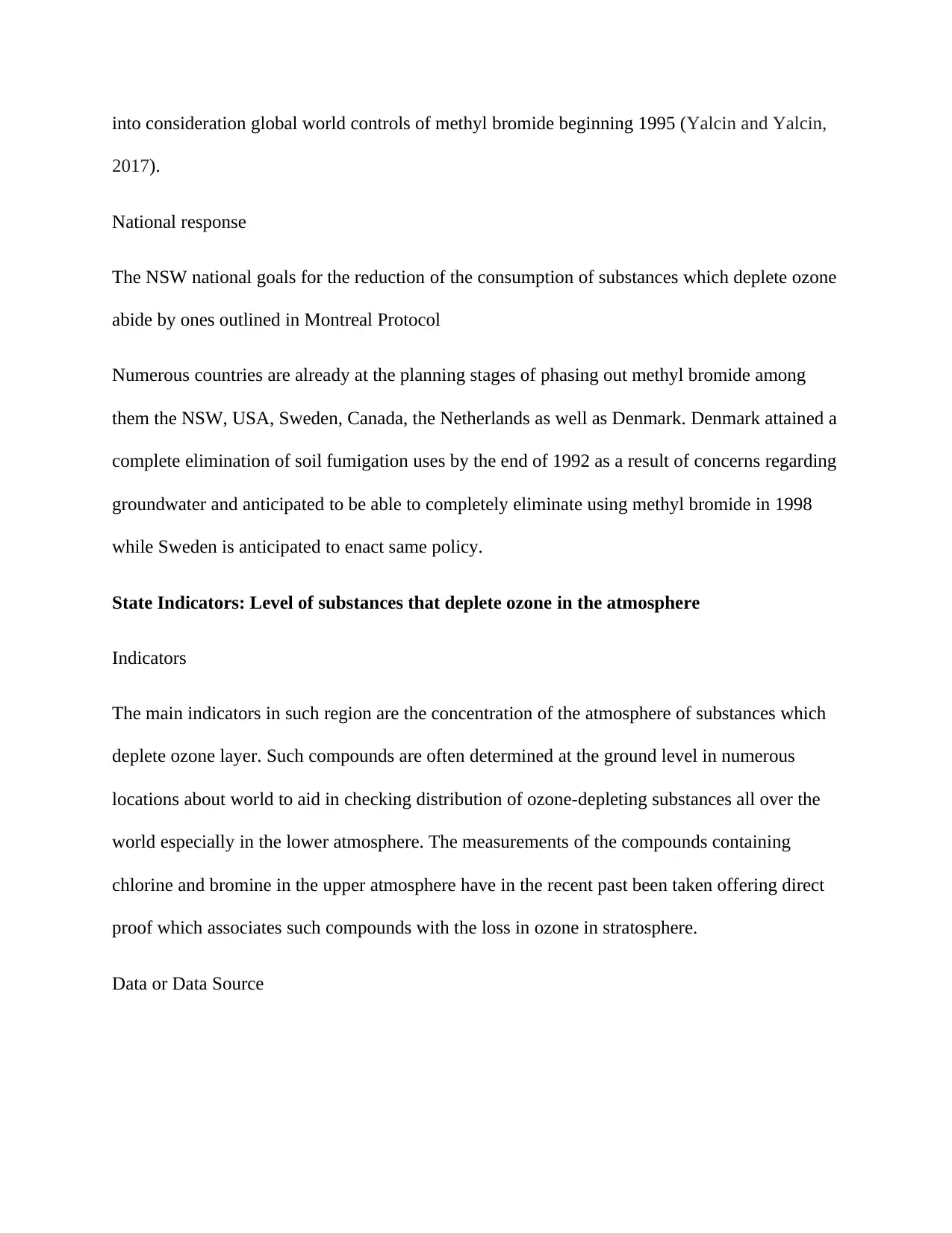
into consideration global world controls of methyl bromide beginning 1995 (Yalcin and Yalcin,
2017).
National response
The NSW national goals for the reduction of the consumption of substances which deplete ozone
abide by ones outlined in Montreal Protocol
Numerous countries are already at the planning stages of phasing out methyl bromide among
them the NSW, USA, Sweden, Canada, the Netherlands as well as Denmark. Denmark attained a
complete elimination of soil fumigation uses by the end of 1992 as a result of concerns regarding
groundwater and anticipated to be able to completely eliminate using methyl bromide in 1998
while Sweden is anticipated to enact same policy.
State Indicators: Level of substances that deplete ozone in the atmosphere
Indicators
The main indicators in such region are the concentration of the atmosphere of substances which
deplete ozone layer. Such compounds are often determined at the ground level in numerous
locations about world to aid in checking distribution of ozone-depleting substances all over the
world especially in the lower atmosphere. The measurements of the compounds containing
chlorine and bromine in the upper atmosphere have in the recent past been taken offering direct
proof which associates such compounds with the loss in ozone in stratosphere.
Data or Data Source
2017).
National response
The NSW national goals for the reduction of the consumption of substances which deplete ozone
abide by ones outlined in Montreal Protocol
Numerous countries are already at the planning stages of phasing out methyl bromide among
them the NSW, USA, Sweden, Canada, the Netherlands as well as Denmark. Denmark attained a
complete elimination of soil fumigation uses by the end of 1992 as a result of concerns regarding
groundwater and anticipated to be able to completely eliminate using methyl bromide in 1998
while Sweden is anticipated to enact same policy.
State Indicators: Level of substances that deplete ozone in the atmosphere
Indicators
The main indicators in such region are the concentration of the atmosphere of substances which
deplete ozone layer. Such compounds are often determined at the ground level in numerous
locations about world to aid in checking distribution of ozone-depleting substances all over the
world especially in the lower atmosphere. The measurements of the compounds containing
chlorine and bromine in the upper atmosphere have in the recent past been taken offering direct
proof which associates such compounds with the loss in ozone in stratosphere.
Data or Data Source
⊘ This is a preview!⊘
Do you want full access?
Subscribe today to unlock all pages.

Trusted by 1+ million students worldwide
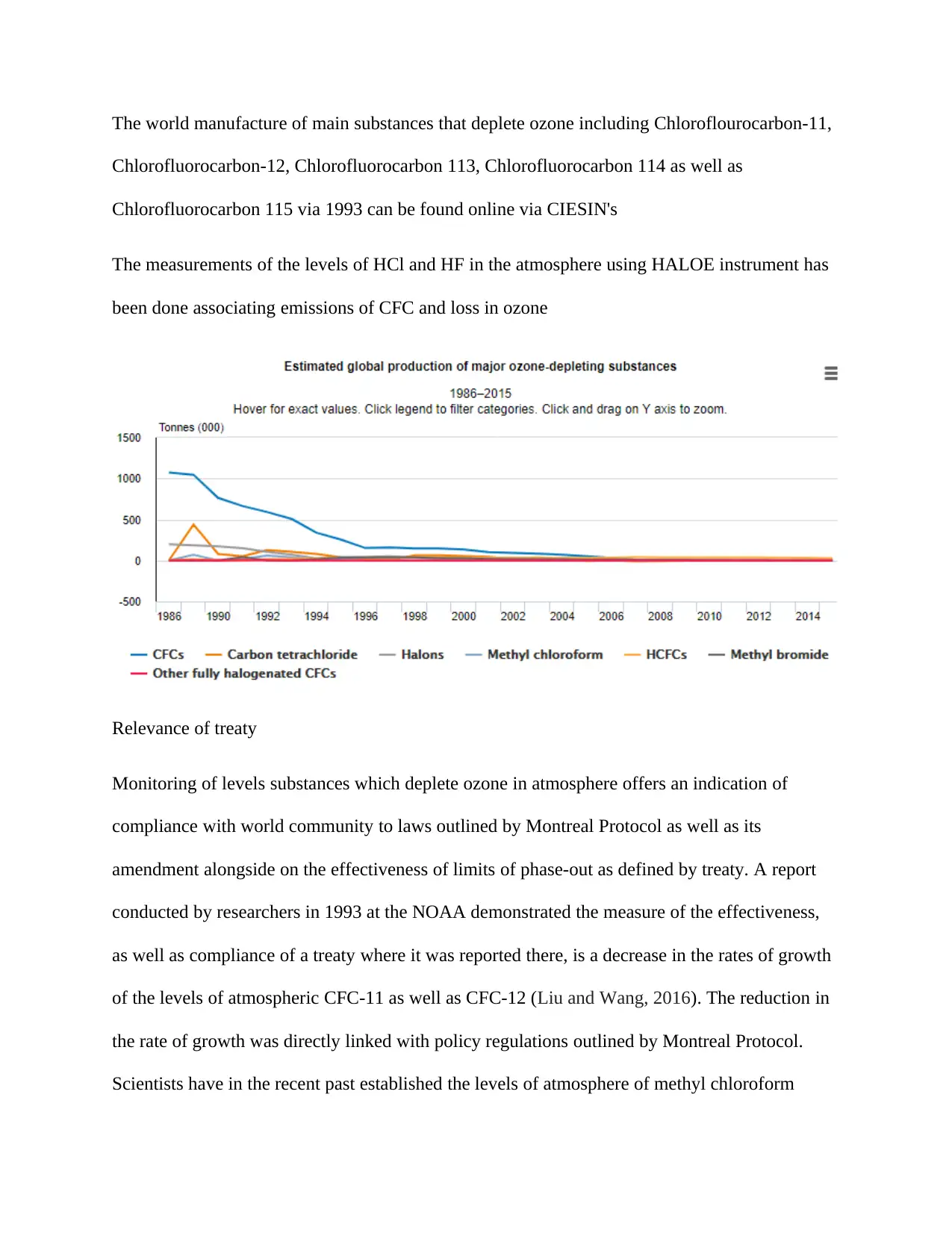
The world manufacture of main substances that deplete ozone including Chloroflourocarbon-11,
Chlorofluorocarbon-12, Chlorofluorocarbon 113, Chlorofluorocarbon 114 as well as
Chlorofluorocarbon 115 via 1993 can be found online via CIESIN's
The measurements of the levels of HCl and HF in the atmosphere using HALOE instrument has
been done associating emissions of CFC and loss in ozone
Relevance of treaty
Monitoring of levels substances which deplete ozone in atmosphere offers an indication of
compliance with world community to laws outlined by Montreal Protocol as well as its
amendment alongside on the effectiveness of limits of phase-out as defined by treaty. A report
conducted by researchers in 1993 at the NOAA demonstrated the measure of the effectiveness,
as well as compliance of a treaty where it was reported there, is a decrease in the rates of growth
of the levels of atmospheric CFC-11 as well as CFC-12 (Liu and Wang, 2016). The reduction in
the rate of growth was directly linked with policy regulations outlined by Montreal Protocol.
Scientists have in the recent past established the levels of atmosphere of methyl chloroform
Chlorofluorocarbon-12, Chlorofluorocarbon 113, Chlorofluorocarbon 114 as well as
Chlorofluorocarbon 115 via 1993 can be found online via CIESIN's
The measurements of the levels of HCl and HF in the atmosphere using HALOE instrument has
been done associating emissions of CFC and loss in ozone
Relevance of treaty
Monitoring of levels substances which deplete ozone in atmosphere offers an indication of
compliance with world community to laws outlined by Montreal Protocol as well as its
amendment alongside on the effectiveness of limits of phase-out as defined by treaty. A report
conducted by researchers in 1993 at the NOAA demonstrated the measure of the effectiveness,
as well as compliance of a treaty where it was reported there, is a decrease in the rates of growth
of the levels of atmospheric CFC-11 as well as CFC-12 (Liu and Wang, 2016). The reduction in
the rate of growth was directly linked with policy regulations outlined by Montreal Protocol.
Scientists have in the recent past established the levels of atmosphere of methyl chloroform
Paraphrase This Document
Need a fresh take? Get an instant paraphrase of this document with our AI Paraphraser
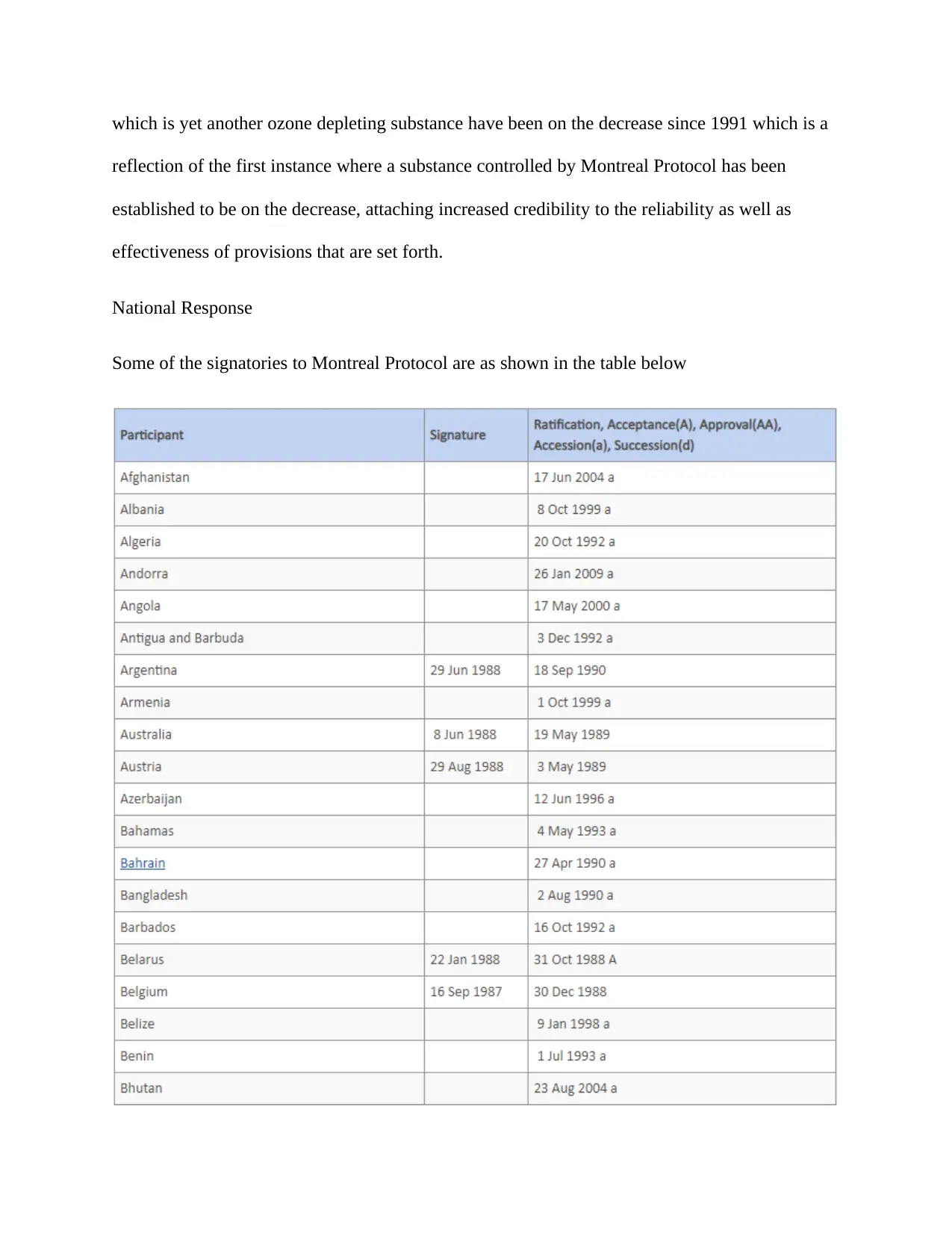
which is yet another ozone depleting substance have been on the decrease since 1991 which is a
reflection of the first instance where a substance controlled by Montreal Protocol has been
established to be on the decrease, attaching increased credibility to the reliability as well as
effectiveness of provisions that are set forth.
National Response
Some of the signatories to Montreal Protocol are as shown in the table below
reflection of the first instance where a substance controlled by Montreal Protocol has been
established to be on the decrease, attaching increased credibility to the reliability as well as
effectiveness of provisions that are set forth.
National Response
Some of the signatories to Montreal Protocol are as shown in the table below
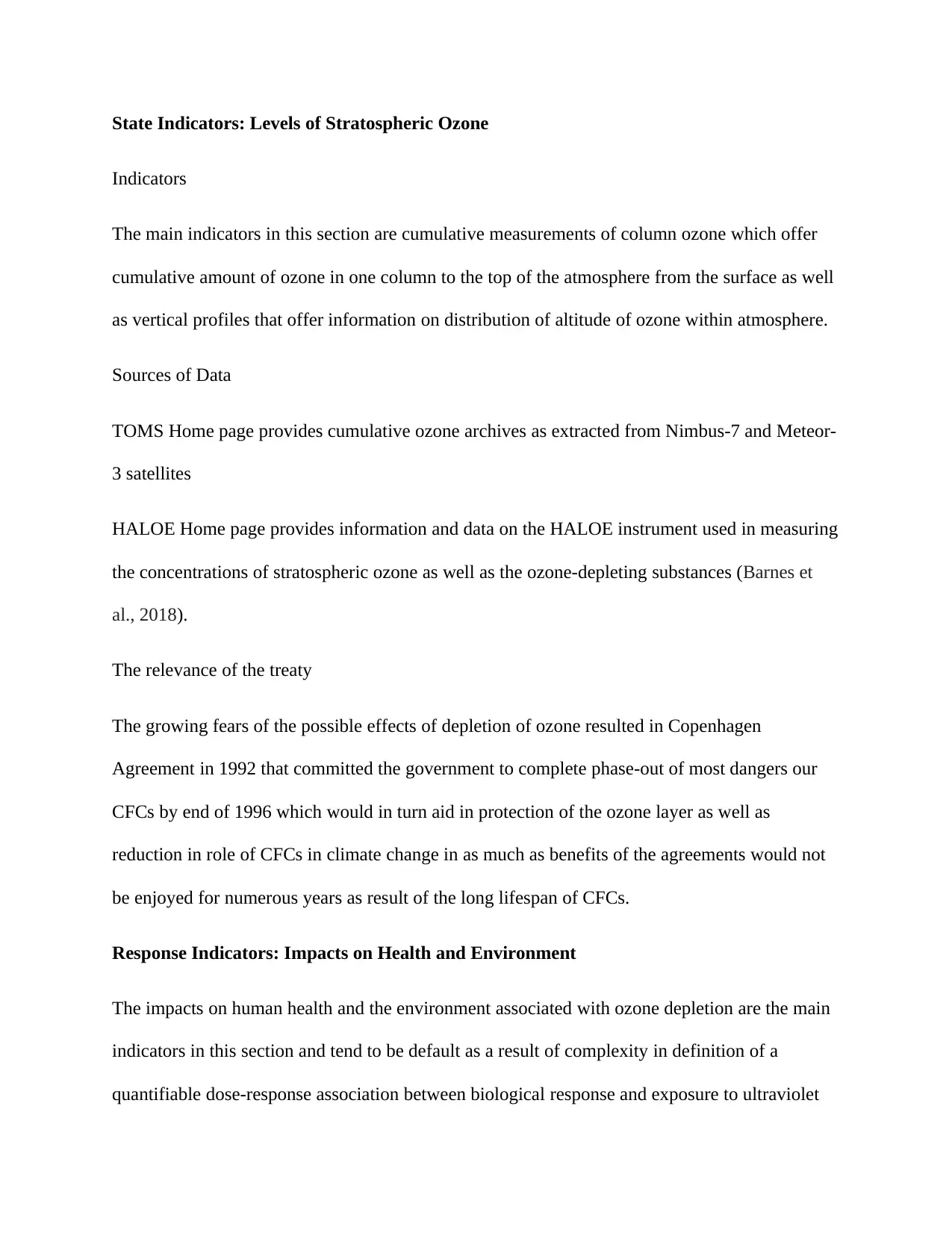
State Indicators: Levels of Stratospheric Ozone
Indicators
The main indicators in this section are cumulative measurements of column ozone which offer
cumulative amount of ozone in one column to the top of the atmosphere from the surface as well
as vertical profiles that offer information on distribution of altitude of ozone within atmosphere.
Sources of Data
TOMS Home page provides cumulative ozone archives as extracted from Nimbus-7 and Meteor-
3 satellites
HALOE Home page provides information and data on the HALOE instrument used in measuring
the concentrations of stratospheric ozone as well as the ozone-depleting substances (Barnes et
al., 2018).
The relevance of the treaty
The growing fears of the possible effects of depletion of ozone resulted in Copenhagen
Agreement in 1992 that committed the government to complete phase-out of most dangers our
CFCs by end of 1996 which would in turn aid in protection of the ozone layer as well as
reduction in role of CFCs in climate change in as much as benefits of the agreements would not
be enjoyed for numerous years as result of the long lifespan of CFCs.
Response Indicators: Impacts on Health and Environment
The impacts on human health and the environment associated with ozone depletion are the main
indicators in this section and tend to be default as a result of complexity in definition of a
quantifiable dose-response association between biological response and exposure to ultraviolet
Indicators
The main indicators in this section are cumulative measurements of column ozone which offer
cumulative amount of ozone in one column to the top of the atmosphere from the surface as well
as vertical profiles that offer information on distribution of altitude of ozone within atmosphere.
Sources of Data
TOMS Home page provides cumulative ozone archives as extracted from Nimbus-7 and Meteor-
3 satellites
HALOE Home page provides information and data on the HALOE instrument used in measuring
the concentrations of stratospheric ozone as well as the ozone-depleting substances (Barnes et
al., 2018).
The relevance of the treaty
The growing fears of the possible effects of depletion of ozone resulted in Copenhagen
Agreement in 1992 that committed the government to complete phase-out of most dangers our
CFCs by end of 1996 which would in turn aid in protection of the ozone layer as well as
reduction in role of CFCs in climate change in as much as benefits of the agreements would not
be enjoyed for numerous years as result of the long lifespan of CFCs.
Response Indicators: Impacts on Health and Environment
The impacts on human health and the environment associated with ozone depletion are the main
indicators in this section and tend to be default as a result of complexity in definition of a
quantifiable dose-response association between biological response and exposure to ultraviolet
⊘ This is a preview!⊘
Do you want full access?
Subscribe today to unlock all pages.

Trusted by 1+ million students worldwide
1 out of 15
Related Documents
Your All-in-One AI-Powered Toolkit for Academic Success.
+13062052269
info@desklib.com
Available 24*7 on WhatsApp / Email
![[object Object]](/_next/static/media/star-bottom.7253800d.svg)
Unlock your academic potential
Copyright © 2020–2025 A2Z Services. All Rights Reserved. Developed and managed by ZUCOL.





